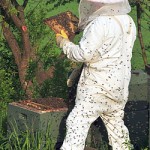
Scientific evidence mounts that neonictinoid toxins devastate hives.
from PANNA, Pesticide Action Network North America
WASHINGTON DC, April 29, 2013 — In a historic vote earlier today, the European Union created continent-wide restrictions on the use of bee-harming pesticides. Despite pesticide industry influence, a majority of countries voted to place a two year restriction on three neonicotinoid products linked to a wide-range of harms to honey bees, namely: clothianidin, imidacloprid and thiamethoxam.
The EU vote comes after significant findings by the European Food Safety Agency that these pesticides pose an unacceptable risk to bees and their use should be restricted. Along with habitat loss and pathogens, a growing body of science points to neonicotinoid pesticides as a key factor in drastically declining bee populations.
Unless US officials act soon, bee populations may not recover, threatening the livelihood of beekeepers and the agricultural economies that rely on pollination.
In Europe, advocates continue to press for even greater restrictions on the use of neonicotinoid pesticides, largely used on sugarbeets and canola. Keith Tyrell, executive director of PAN-UK, said, “Whilst we welcome the EU vote as a significant step forward, we are dismayed that it is only a temporary half measure which goes nowhere near far enough in protecting our bees and other vital pollinators from the harm of neonicotinoid pesticides. PAN UK will continue to campaign for a complete moratorium on the use of neonicotinoid pesticides, and for a thorough and independent review of the scientific research on the subject.”
© Copyright 2013 Pesticide Action Network North America, All rights Reserved. Written For: StraightGoods.ca
2 Responses to “Europe restricts pesticides blamed for bee deaths”
Sorry, the comment form is closed at this time.


any beekeepers in south eastern Ontario reading this?
several 1-4 hive operators report 100% hive death winter 2013
one commercial keeper reports 50% hive death (35 of 70 hives)
summer 2012 high number of swarmings
no commercial agriculture near here
is there any agency keeping stats?
comments?
should have said all within a 20 mile radius